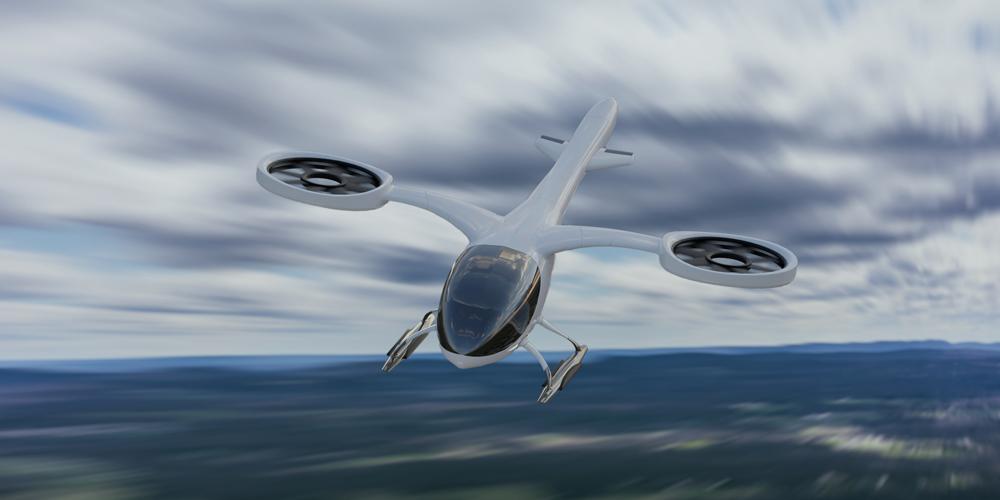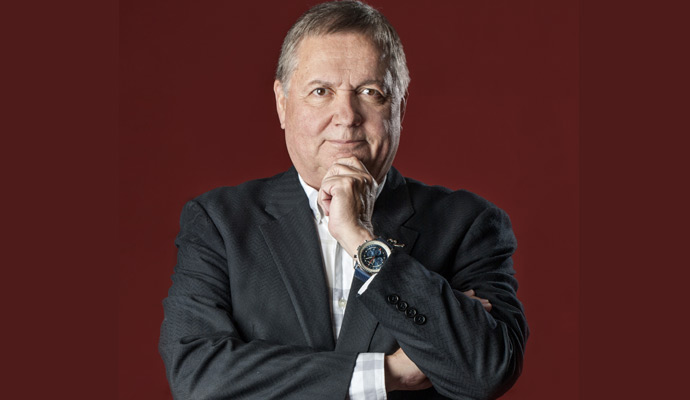Electric planes take off
The potential for short-haul electric flight is energizing aviation’s newest startups.
Two airports in Spain illustrate both the past and future of commercial aviation. In the country’s east, more than 100 jet aircraft, including giant A380s, glisten like a mirage under a scorching Iberian sun at Teruel Airport, a parking lot for technology past. Only a few of these gas guzzlers are likely to fly again. Around 250 miles to the south, the ATLAS Flight Test Centre in Villacarrillo is providing a runway for a new breed of much smaller aircraft: electric vertical takeoff and landing planes, or eVTOLs.
With more countries and companies agreeing to reduce emissions, the future for the bulky jets we fly in today and the companies that operate them is changing. “The biggest challenge to commercial aviation is the commitment that’s been made to net-zero carbon emissions by 2050,” Tony Douglas, group CEO of Etihad Aviation Group, told the Global Aerospace Summit in Abu Dhabi in May. Flying accounts for only 2.5% of CO2 emissions. But those emissions are created by the relatively small proportion of humans who fly each year, and the industry is poised to expand. It will be very difficult to reduce flying-related emissions without grounding airplanes. “I imagine everybody in this room understands that the physics of powered flight render the achievement of that objective [net zero] extremely difficult anytime soon,” Douglas added.
Not surprisingly, engineers and scientists around the globe are in a race to crack the nut of zero-emissions flying. The challenge of replicating the electric vehicle (EV) revolution in the air is that, simply put, defying gravity requires more energy. Moving a heavy battery along a flat road in a car is easier than lifting it into the air on a plane or helicopter. (Clean airplane fuels, which are liquids or gases derived from sustainable sources, are still very expensive and, according to a PwC report, won’t be widely available or cost-effective for more than a decade. But they are still likely to be the fuel of the future for long-haul flying.)
The challenge of replicating the EV revolution in the air is that, simply put, defying gravity requires more energy.
From makeshift garages to big-name multinationals, designers and mechanics are pushing their 3D printers hard sculpting prototypes, and a few are already test-flying their electric aircraft. Some are starting from scratch; others are looking to retrofit existing planes. And then there are the eVTOLs, which could become the helicopter taxis of the future. Not unlike the Wright Brothers, many innovators have repeatedly been forced back to the drawing board, designing and testing new fuselages, motors, and fuels. (So far, a hybrid plane has flown 341 miles, and a battery-powered helicopter has stayed in the air for 15 minutes.) All that experimentation may be paying off: the first electric-powered aircraft could start operating as early as 2024, potentially flying routes like New York to Philadelphia or Rhode Island without emitting CO2.
One indication of who may come out on top in the technology stakes is to follow the money. Airlines and investors are looking at both short-haul electric planes and the eVTOL prototypes. Over half a dozen eVTOL startups have raised several billion dollars in the past year: Archer Aviation, Joby Aviation, and Wisk, all from California; Germany’s Lilium and Volocopter; Vertical Aerospace of the UK; and Brazil’s Eve.
Big-ticket orders have come in from American Airlines, which last year announced a US$25 million investment in Vertical Aerospace and a $1 billion preorder of 250 of its VX aircraft, which can carry four passengers and have a range of 100 miles. Archer Aviation secured funds in excess of $1 billion from a group of companies including United Airlines. Car-makers, too, want a piece of the fast-growing eVTOL pie, with Stellantis taking a minority stake in Archer; Honda is developing its own hybrid air taxi.
“Once the challenges of sustained battery-powered or carbon-free flight are overcome, the opportunities available in short order to those companies that succeed are immense,” says Neil Baxter, a PwC partner based in Seattle. “Within the United States, nearly half of all scheduled commercial flights are less than 500 miles and could be delivered by carbon-free aircraft, so there is huge potential for an immediate impact.”
The underlying business model for airlines looking to buy electric planes is the idea that cheaper operating costs, owing to reduced fuel and maintenance expenses, will allow more point-to-point flights, thus tapping into a vast, underutilized network of local and regional airfields and helping to decongest big airports and highways.
In 2020, AeroTEC, a company based in the growing aviation corridor east of Seattle, flew the world’s largest all-electric plane at its test center in Moses Lake, retrofitting a conventional Cessna Grand Caravan with batteries and with cutting-edge electric motors developed by magniX, a company specializing in electric propulsion technology. While the flight was a big step in exploring next-generation aviation, it also made clear that it would be a long road ahead. The weight of the batteries in the Grand Caravan essentially meant the plane couldn’t carry any passengers or cargo.
“We recognized back in 2019 and [during] the flight demos that we did in 2020 that the maturity of the technologies was not production-ready,” says AeroTEC president and CEO Lee Human. “But you never get to production if you don’t try and you don’t start.” Far from giving up, AeroTEC and magniX are now producing hybrid planes that can run on both fuel and battery-driven electric motors, much like a hybrid car. Surfair, a Los Angeles–based air travel company, signed an agreement last spring with AeroTEC and magniX to equip its fleet of Cessna planes with hybrid and electric powertrains. It expects doing so will reduce the company’s CO2 emissions by 50% and operating costs by 25%.
The potential market for retrofitting is huge. There are currently more than 15,000 turboprop aircraft with between nine and 19 seats flying regional routes, according to Surfair. In a sign of the entrepreneurial spirit permeating the electric-aviation industry, Human is also experimenting with hydrogen fuel, which at 1,000 watt-hours per kilo has roughly four times the energy of an installed battery system. “We’re taking fuel cells out of a bus, and we’re putting them in an airplane,” Human says, as if he were building a go-kart.
Still, Human believes batteries will evolve quickly and may prove more reliable and easier to handle than hydrogen. “We know technology advances rapidly. It’s not inconceivable that in ten years we’ll have batteries that [provide] 800 watt-hours per kilo.”.
AeroTEC’s neighbor, Eviation, took a radically different approach by designing an entirely new aircraft whose porpoise-like shape creates less drag than conventional planes. Alice, as the aircraft is known, can carry up to nine passengers and fly 880 kilometers, enough to go from Munich to Paris, at a speed of 400 kilometers per hour. Scheduled to test-fly this summer in Moose Lake, Washington, Alice is powered by two 640-kilowatt motors, also made by magniX, that have as much power as 4,260 standard electric scooters.
“It’s the biggest change in the aircraft industry since the world went from the Super Constellation to the 707,” says Gregory Davis, president of Eviation, in reference to the aircrafts that symbolized the switch from piston-propeller propulsion to jets. “We’re going to the next era of aviation.” Eviation was cofounded by Israeli physicist Omer Bar-Yohay and, like magniX, is majority-owned by Singapore-based Clermont investment group, which is controlled by New Zealand–born billionaire Richard Chandler.
The prospect of zero emissions and a projected cost reduction of 30 to 50% has already won Eviation two customers. Massachusetts-based commuter airline Cape Air intends to purchase 75 aircraft. Global cargo giant DHL hopes to incorporate a dozen Alice eCargo planes into its fleet by 2024, citing the quick charging time of 30 minutes per hour of flight time as an attraction.
When it comes to sparking the imagination, eVTOLs hold a special appeal. It’s not quite a flying car in every driveway, but some of the prototypes already on the market portend a future of remarkable urban mobility. Unlike conventional helicopters, their electric cousins can’t carry as much weight or fly as far. But they tend to be quieter (thanks to the electric motor), safer (thanks to multiple, smaller rotors), and cheaper to operate (thanks to lower maintenance and fuel costs).
Balkiz Sarihan, head of strategy at Airbus’s Urban Air Mobility, envisions three niche markets for the company’s City Airbus, a four-seat eVTOL currently in development: as an airport shuttle, an ambulance, and a minibus for ecotourism. “We are developing solutions that extend the capabilities of classic helicopters and in some cases create new markets,” Sarihan says. Indeed, a lot of time and energy went into designing the rotors for the eight motors, so they would leave a minimum noise footprint. “It’s not just the decibels of the noise but the acoustics,” says Sarihan.
For now, no additional infrastructure is needed for eVTOLs beyond a charging station, as the City Airbus and most other prototypes can use existing helipads. In the future, Sarihan says, one could envision specialized vertiports, perhaps adjacent to train stations, complete with shops and other airport-like amenities. “But we don’t need that from Day One.”
Judging by the number of electric-aviation startups—Eviation’s Davis estimates that there are some 400—it’s easy to imagine as much traffic in the skies above Manhattan and other congested city centers as on the ground in only a few years. “We won’t have hundreds of types of vehicles operating, but also not one or two,” says Sarihan. “There are different architectures suited for different mission types. It’s not a one-type-fits-all and absolutely not a winner-takes-all type of market.”
A precondition for success is not just lots of money but also expertise and patience. From the drawing board to flying your first passengers can easily take six, eight, or ten years. It’s not only the technological challenges that slow the pace but also the strict certification and safety requirements, which call for high levels of redundancy.
“If you’re going to go down a path, and you’re going to get 500 to 1,000 people, use a billion dollars, and you’re going to design something, you’ve got to make sure that it’s going to be competitive for a decade or two. Otherwise it’s not worth it,” says Alexander Asseily, vice chairman of Lilium, a Munich-based eVTOL startup in which he was an early investor. “It’s not like an iPad—we launch it, they like it, and after two years we’re going to upgrade it. It doesn’t work like that.”
Meanwhile, on the roasting tarmac at Teruel, the massive multi-engine jets that were once lauded as the future of aviation are waiting to be stripped for parts, sold, or redeployed when demand spikes. As Asseily, a mechanical engineer by training who has invested in disruptive technologies his entire career, succinctly puts it, “Aerospace is hard.” That‘s as true for eVTOLs as for any planes, he adds—up to a point. “Electric aerospace is novel; vertical electric aerospace is technically hard and novel. But it’s also very sexy and exciting, which is why it’s attracted a lot of capital.”
Author profile:
- Raymond Colitt is a journalist with three decades of experience reporting, writing, and editing stories from around the globe, including Brazil, Germany, and the US. He has worked for the Financial Times, Reuters, and Bloomberg and currently divides his time among Berlin, Los Angeles, and Brasilia.




